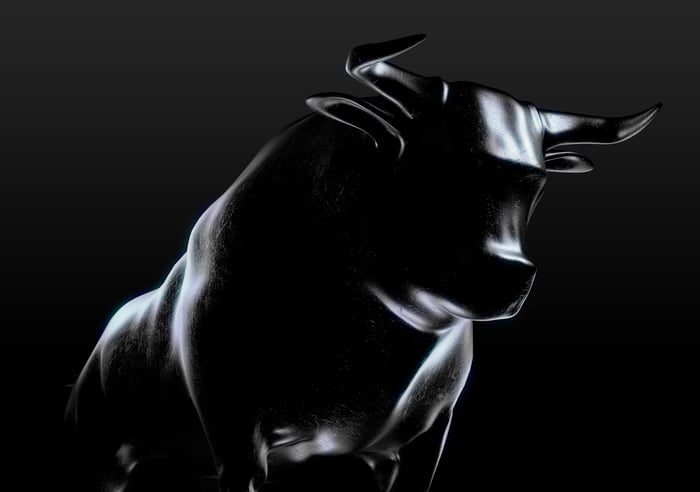When investors look back on 2020, they'll likely remember it as the year that crammed in about a decade's worth of volatility. During the first quarter, the widely followed S&P 500 (^GSPC 0.87%) shed more than a third of its value in just 33 calendar days. For context, the S&P 500 has historically taken an average of 11 months to decline at least 30% during bear markets.
We've also witnessed an almost unrelenting rally in equities since the March 23 bottom. The S&P 500, Dow Jones Industrial Average (^DJI 0.67%), and Nasdaq Composite (^IXIC 1.11%) have surged by 66%, 62%, and 86%, respectively, as of last weekend. In fact, it took less than five months for the S&P 500 to reclaim new highs, which marks the quickest rebound from a bear market in history.
These gains could be just the tip of the iceberg for all three major indexes. As we prepare to move headlong into 2021, here are four catalysts that could ignite a raging bull market.

Image source: Getty Images.
1. Coronavirus vaccine efficacy and uptake end the pandemic
The single greatest economic driver in 2021 is going to be coronavirus disease 2019 (COVID-19) vaccines. This month, we've seen the U.S. Food and Drug Administration grant emergency use authorization to BNT162b2 from Pfizer and BioNTech, as well as mRNA-1273, which was developed by Moderna. These vaccines produced vaccine efficacy of 95% and 94.1%, respectively, blowing researchers' expectations out of the water.
Despite this efficacy, ending the pandemic isn't a slam-dunk. Pfizer/BioNTech and Moderna need to produce hundreds of millions of doses of these vaccines (two doses are required per adult). Federal and state regulators also need to decide how to most effectively distribute these vaccines to the public.
The biggest deciding factor will be uptake of the vaccine. Major news outlets and drug developers have suggested there will be a dose available to every adult who wants one by mid-2021. Yet, according to a September poll from Pew Research, only 51% of people surveyed were definitely or probably getting the vaccine. If the percentage of adults who get the vaccine tops approximately 75%, according to Dr. Anthony Fauci, herd immunity could be achieved.
If at least 191 million adults get the vaccine, life could presumably return to normal within the next year.

Image source: Getty Images.
2. Federal stimulus allays financial worries
A second catalyst to a raging bull market in 2021 would be another round of fiscal stimulus from Capitol Hill.
It seemingly took no time for lawmakers to approve the $2.2 trillion CARES Act in March. Then again, the country was facing an unknown disease and an unprecedented economic dilemma at the time. Congress has been tinkering with a second major COVID-19 stimulus package for five months now. Although a new deal now seems imminent, nothing has yet been set in stone (as of late evening, Monday, Dec. 21).
The roughly $900 billion package currently under consideration would give some Americans another stimulus check of at least $600, potentially boost federal unemployment benefits by $300 a week for a period of 10 to 16 weeks, and provide additional funding for coronavirus vaccine rollouts.
Another round of stimulus would allay fears from landlords and financial institutions, which are likely worried about the potential for rapidly rising loan and credit delinquencies without some form of federal assistance.
President-elect Joe Biden has also strongly hinted at passing additional stimulus once he's in office. Look for this stimulus to drive equities higher.

Image source: Getty Images.
3. Dovish monetary policy fuels high-growth stocks
Another must-have for a strong bull market next year is dovish monetary policy from the nation's central bank.
The Federal Reserve has plainly stated that it has no intention of raising its federal funds rate -- the rate banks charge each other for overnight lending -- until at least 2024. In plain English, this pledge means interest rates (and therefore borrowing costs) are going to remain at or near record lows.
What's more, the Federal Reserve has also been buying $120 billion in government-backed debt each month. Since bond prices and bond yields are inversely related, buying bonds should drive up their price and reduce yields. This is a secondary way the nation's central bank is keeping lending rates near historic lows.
This is particularly important because high-growth tech stocks have been the primary catalyst of the stock market's 2020 rally. Historically low borrowing costs should allow high-growth tech and healthcare stocks to hire, innovate, and acquire other businesses.

Image source: Getty Images.
4. History repeats itself
Last but not least, history might have a say in sending the S&P 500, Dow Jones, and Nasdaq Composite significantly higher in 2021.
Though nothing is predictable when it comes to investing, a few historical patterns may give investors an edge from time to time. For example, the S&P 500 has historically returned about 7% annually, including dividends paid, over the long run. This implies that long-term investors can, on average, expect to double their money about once a decade.
What's even more interesting is how the S&P 500 fares after generating a double-digit total return (i.e., including dividends paid). Since 1975, there have 28 years where the S&P 500 delivered a 10%+ total return, nine years with a positive single-digit total return, and eight years with a negative total return. In other words, 82% of the time over the last 45 years, the S&P 500 has ended the year higher on a total return basis.
But in the immediate year following a total return of at least 10%, the S&P 500 delivered another double-digit total return 61% of the time.
If history repeats itself, we could see the bulls run wild in 2021.




